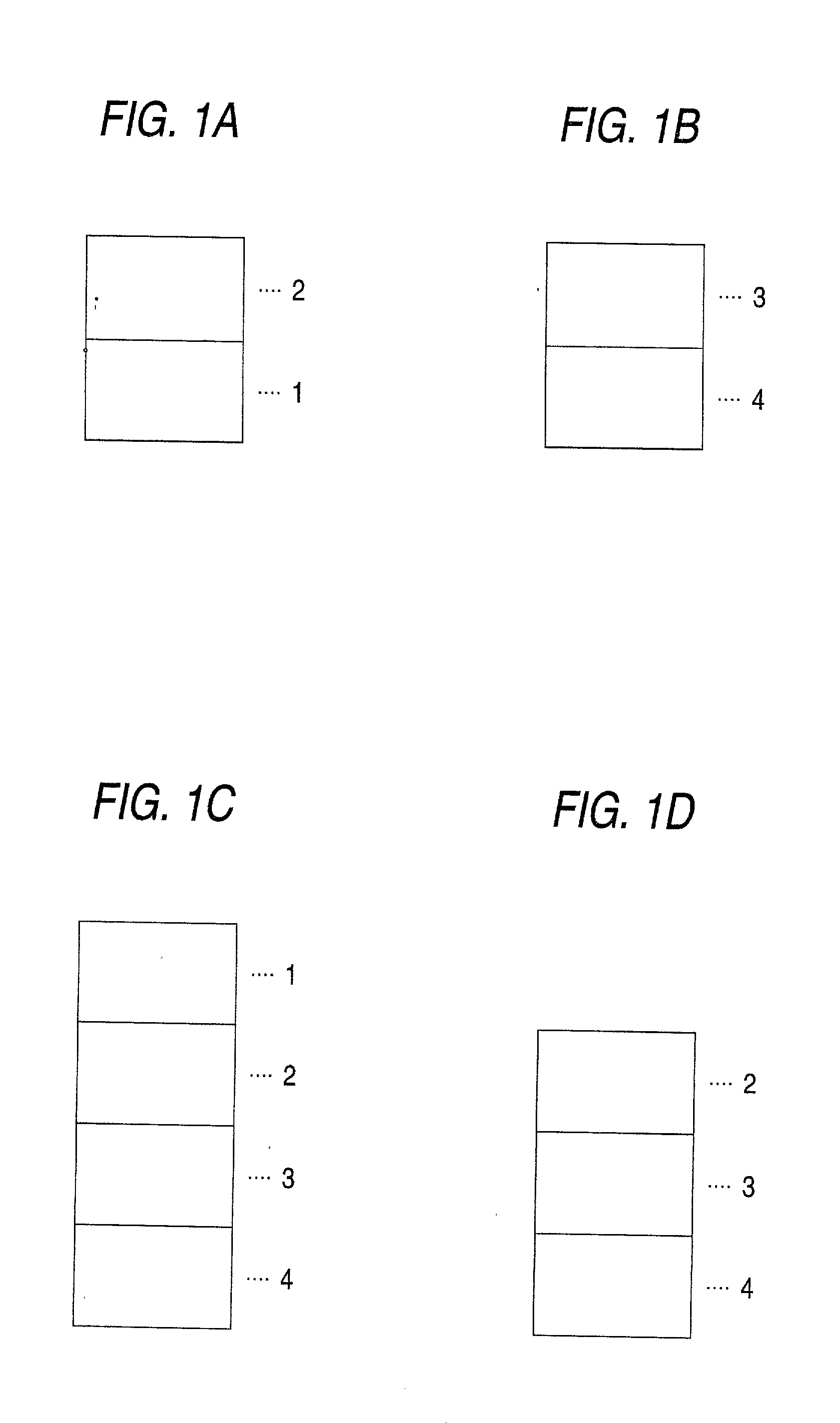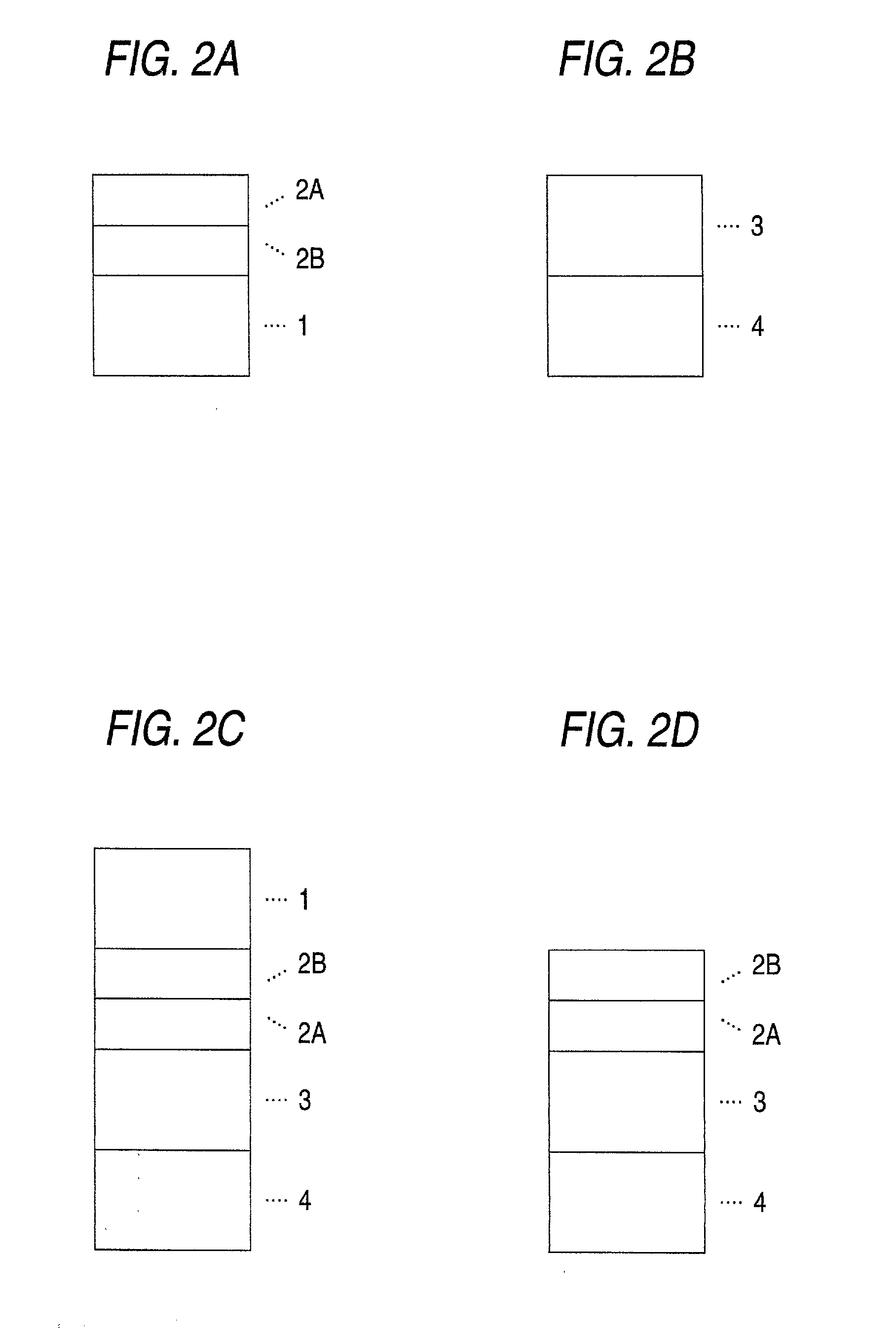As a result, a high gloss cannot be obtained.
Further, such a
system is disadvantageous in that the support to be used is limited to a transparent material.
However, these ink jet recording materials which absorb an ink by the
dissolution and swelling of such a resin are disadvantageous in that it has a low ink
drying rate and a high hydrophilicity and thus can be easily dissolved in water and exhibits a poor
water resistance.
However, this proposal is disadvantageous in that the gloss-developing layer can easily sink in the recording layer.
Further, an excellent gloss cannot be obtained.
Further, dots are fused to each other, making it impossible to provide prints having a high
fineness.
The cast-
coated paper obtained according to the foregoing process is disadvantageous in that the resulting
coating layer loses
porosity due to the presence of the film-forming substance and hence exhibits a reduced ink absorption during ink jet recording.
However, since the gloss-developing layer can be cracked similarly to the above mentioned case, prints having a high
fineness cannot be obtained.
Further, since it is necessary that
water vapor or the like pass through the coating layer and paper during
drying, pinholes can be easily formed, making it impossible to obtain an ink jet recording material having excellent gloss, smoothness and luster as high as photograph.
In other words, a film-based (including laminated paper) cast-coated sheet is difficult to be prepared.
However, lamination after printing has a problem of mechanical facility and high cost and thus cannot be normally applied.
Thus, the control over the
drying condition is extremely difficult.
Further, when the transferring sheet is laminated on the coating layer, air bubbles or the like can be easily contained in the coating layer, making it impossible to obtain a high smoothness.
Accordingly, an ink jet recording material having a gloss and smoothness as high as photograph can hardly be obtained.
Further, such a system is disadvantageous in that the support to be used is limited to a transparent material.
However, if the size of
pigment particles is increased, the surface of the recording layer cannot be provided with smoothness.
Thus, a color recording having a high gloss which is as beautiful as photograph cannot be obtained.
Such a recording layer has an excellent
water resistance but normally has no smoothness and gloss.
Thus, the desired smoothness and gloss can hardly be obtained.
Further, since the recording layer is porous, numeral air bubbles are formed in the
adhesive layer, eliminating the smoothness of the recording layer and hence impairing the external appearance.
Moreover, since the resulting coat layer has no
water resistance, a satisfactory ink jet recording material cannot be obtained.
However, since the ink-receiving layer using secondary particles (agglomerates) has a porous surface that scatters light, it is impossible to obtain an image having good photographic properties such as excellent gloss, luster and transparency.
However, this type of a
coated paper is greatly disadvantageous in that it lacks gloss or is inferior in water resistance.
However, the ink absorption and gloss could hardly be balanced.
Further, the resulting ink-receiving layer has some
surface roughness that impairs the smoothness thereof.
Thus, there is a possibility that an ink jet recording which can exhibit a high gloss after printing cannot be obtained.
On the contrary, if the added amount of the
adhesive falls below the above defined range, the ink-receiving layer can be drastically cracked on the entire surface thereof, impairing the transparency thereof.
If the coated amount falls below the above defined range, the resulting coating film can be cracked.
On the contrary, if the coated amount exceeds the above defined range, the resulting effect is uselessly saturated.
Therefore, the resulting ink-receiving layer has an extremely small void between particles.
If the added amount of the other ink-receiving
layers falls below this range, the resulting ink absorption is insufficient.
On the contrary, if the added amount of the other ink-receiving
layers exceeds this range, the resulting effect is uselessly saturated.
If the coated amount of the interlayer falls below this range, a sufficient adhesivity can hardly be obtained.
On the contrary, if the coated amount of the interlayer exceeds this range, the resulting effect is uselessly saturated.
If the coated amount of the peelable resin falls below this range, a desired effect by surface treatment can hardly be exerted.
If the coated amount of the peelable resin exceeds this range, the resulting effect is uselessly saturated.
On the contrary, if the content of the pigment exceeds this range, the film-forming properties of the recording layer can be deteriorated.
On the contrary, if the average particle
diameter of the pigment exceeds this range, the recording layer thus formed can be observed to have a
surface roughness that makes it difficult to obtain a high gloss.
On the contrary, if the coated amount of the recording layer exceeds this range, the resulting effect is uselessly saturated.
If the coated amount of the upper layer falls below this range, the resulting effect of the upper layer is not sufficient.
On the contrary, if the coated amount of the upper layer exceeds this range, it takes much time for the ink to permeate therethrough, reducing the ink absorption rate.
The reason for this definition is unknown but is probably because if the
water content of the recording layer exceeds 20%, the adhesivity between the forming material and the recording layer is stronger than that between the
layers constituting the recording layer, causing the layers constituting the recording layer to be peeled off each other when the forming material is peeled off the laminate and hence leaving the recording layer on the forming material and making it impossible to obtain a desired ink jet recording sheet.
Further, if the colloidal particles contain particles having an average particle
diameter of not less than 200 nm incorporated therein, the resulting upper layer disadvantageously exhibits a deteriorated transparency.
However, if the upper layer is anionic, the ink is not fixed in the upper layer.
Thus, if the ink absorption rate is low, the ink flows over the surface of the upper layer, causing ink
stain.
On the contrary, if the coated amount of the upper layer exceeds 20 .mu.m, the ink absorption rate can be disadvantageously affected.
If the coated amount of the lower layer falls below this range, the ink absorption disadvantageously runs short.
On the contrary, if the coated amount of the lower layer exceeds this range, the resulting effect is uselessly saturated.
On the contrary, if the weight ratio of the adhesive falls below this range, the resulting ink-receiving layer can be disadvantageously cracked.
On the contrary, if the coated amount of the lower layer exceeds this range, the resulting effect is uselessly saturated.
If the coated amount of the ink-absorbing layer falls below this range, the resulting ink absorption disadvantageously runs short.
On the contrary, if the coated amount of the ink-absorbing layer exceeds this range, the resulting effect is uselessly saturated.
If the
polymerization degree exceeds 1,100, the PVA solution has an increased
viscosity and hence a remarkably reduced
miscibility with colloidal silica, making it difficult to obtain a uniform dispersion of colloidal silica and PVA.
The resulting ink-receiving layer exhibits deteriorated transparency and gloss.
If the percent
saponification falls below 95%, the resulting ink-receiving layer can be easily dissolved in water and thus cannot be provided with a desired water resistance.
On the contrary, if the weight of colloidal silica exceeds the above defined range, the resulting ink-receiving layer can be cracked.
If the coated amount of the ink-receiving layer falls below this range, the ink cannot occasionally be fully absorbed during
high density recording.
On the contrary, if the coated amount of the ink-receiving layer exceeds this range, the resulting effect is uselessly saturated.
If the coated amount of the foregoing one layer falls below this range, the film-forming properties are deteriorated.
If the coated amount of the lower layer falls below this range, the ink absorption can be insufficient.
On the contrary, if the coated amount of the lower layer exceeds this range, the resulting effect is uselessly saturated.
 Login to View More
Login to View More 

